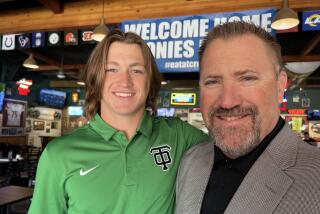SPOTLIGHT / SATURDAY’S GAMES AT A GLANCE : HEISMAN MUDDLE
- Share via
As the race for this season’s Heisman Trophy intensified, some Southern California voters were riveted by Saturday’s action.
One Southland voter, speaking moments before kickoff in San Diego: “That Miami-San Diego State game should say a lot. Marshall Faulk and Gino Torretta are really something.”
But what does it prove if Torretta, the Hurricanes’ senior quarterback, has a sterling performance against the porous San Diego State secondary? The Aztecs, after all, gave up 520 total yards and 45 points in losing to Fresno State last week.
Voter: “Oh! Good point.”
And what if Faulk, who is suffering from a sprained right knee, does not play?
Voter: “Uh. That’s right.”
Yes, they’ve got this voting thing down to a science.
Without a clear-cut favorite, the 1992 race to name the best college football player has some past winners befuddled.
“Right now, I have no clue,” said the Raiders’ Tim Brown, who won the Heisman in 1987 as a Notre Dame wide receiver. “This is a mess, but the bottom line is I’ve got to do something.”
California has 55 votes, including 11 past winners. The other 44 are from the media. Chuck Benedict of Glendale, a one-time Southern California broadcaster who collects the state’s votes, said ballots are due by 5 p.m., Dec. 10. The winner will be announced Dec. 12.
Gary Beban, the 1967 winner from UCLA, said he expected the winner to come out of the San Diego State-Miami game, although he realized Faulk might not play. As it turned out, Faulk, the country’s leading rusher, did not because of an injured knee.
“Maybe this is one one of those years where you will find an unusual choice,” said Beban.
Charles White, the 1979 winner from USC, was most impressed by Faulk. But then, White, also once a great runner, appreciated Faulk’s numbers in the season-opener against the Trojans. That day in September, Faulk gained 220 yards in 27 carries and scored three times in a 31-31 tie.
Les Horvath of Glendale, the 1944 winner for Ohio State, has taken a systematic approach to the problem. He has charted the exploits of seven athletes his season, and was scrutinizing two, Torretta and Georgia’s Garrison Hearst, on Saturday.
“I think it might come down to the performances today,” Horvath said.
But he lamented the matchup of Torretta against the, well, putting it nicely, mediocre Aztec defense.
“What happens with Torretta throwing the ball against a secondary everybody else has scored a lot of points on?” Horvath pondered. “This is a team that defensively hasn’t been able to stop anybody. It makes it a tough selection this year.”
Horvath, a tailback-quarterback for the Buckeyes, thinks Faulk’s chances were hurt because of the injury.
“No matter what the reason, if you’ve had a bad day, an injury . . . you’re not supposed to have those things,” he said.
Still, the voters cannot help but notice that all the leading names being bandied about have been slugs at least once this season. Torretta has a 25-1 record as a Miami starter, but had three interceptions against Syracuse last week.
“It’s up for grabs,” Horvath concluded.
Faulk finished with an average of 163 rushing yards per game to lead the nation. Hearst, who ran for 169 yards Saturday, averaged 140.6 yards. Torretta passed for 310 yards Saturday and was among nation’s leaders in total offense.
More to Read
Go beyond the scoreboard
Get the latest on L.A.'s teams in the daily Sports Report newsletter.
You may occasionally receive promotional content from the Los Angeles Times.










